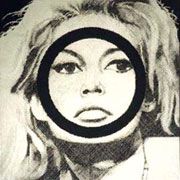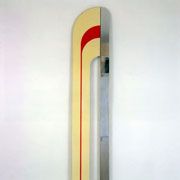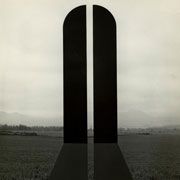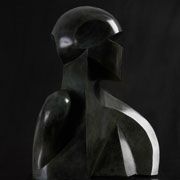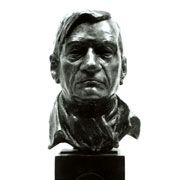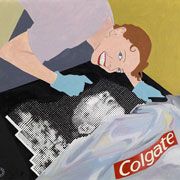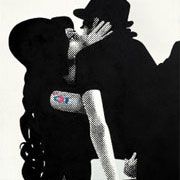
Catalogue Raisonné. Skydiver VI
Search the Catalogue
Skydiver VI
Catalogue No. 43
Artist's CR 041
1964
London
Oil on irregular, shaped canvas
83 x 62 inches / 211 x 157 cm
Collection: Tate Collection
- (Richard Feigen Gallery, New York)
- Private collection
- Collection of Tate Collection
- Four Young Artists, Institute of Contemporary Arts, London, 1964
- 1971: Gerald Laing, Scottish National Gallery of Modern Art, Edinburgh, 1971
- Gerald Laing: Paintings and Sculpture 1963–1983, Herbert Art Gallery & Museum, Coventry, 1983
- Art and the 60s: This Was Tomorrow, Tate Britain, London, 2004
- Space, Speed, Sex: Works from the early 1960s by Gerald Laing, Hazlitt Holland-Hibbert, London, 2006
- Four Young Artists, exhibition catalogue, Institute of Contemporary Arts, 1964
- Gerald Laing and Alasdair Hamilton, 1971: Gerald Laing, exhibition catalogue, Scottish National Gallery of Modern Art, 1971
- Gerald Laing, Kinkell: The Reconstruction of a Scottish Castle, Latimer New Dimensions (1st edition 1974) and Ardullie House (2nd edition 1984), London (1974) and Dingwall (1984), 1974
- Gerald Laing: Paintings and Sculpture 1963–1983, exhibition catalogue, Herbert Art Gallery & Museum, 1983
- The Tate Gallery 1982–84: Illustrated Catalogue of Acquisitions, Tate Gallery, London, 1986
- Jeremy Watson, '‘Immoral’ War Inspires Art Legend', Scotland on Sunday, 5 September
- Chris Stephens and Katharine Stout (eds.), Art and the 60s: This Was Tomorrow, exhibition catalogue, Tate Britain, 2004
- Space, Speed, Sex: Works from the early 1960s by Gerald Laing, exhibition catalogue, Hazlitt Holland-Hibbert, 2006
Catalogue entry
T03842 Skydiver VI 1964
Oil and pencil on canvas mounted on two stretchers attached to one another, top one 22 × 57 3/4 (559 × 1467), lower one 58 × 47 5/8 (1473 × 1210), overall dimensions 80 × 57 3/4 (2032 × 1467)
Inscribed ‘SKYDIVER 6 1964/GERALD LAING’ on back of top canvas
Purchased from the artist (Grant-in-Aid) 1984
Exh: 4 Young Artists, ICA, October–November 1964 (4); Gerald Laing, Scottish National Gallery of Modern Art, Edinburgh, June–August 1971 (2); Gerald Laing Paintings and Sculpture 1963–1983, Herbert Art Gallery, Coventry, September–October 1983, (2, repr.)
Gerald Laing studied at St Martin’s School of Art, London, from 1960–4, and ‘Skydiver VI’ was painted during his last year at St Martin’s, at home in his studio at 12 Fournier Street, Whitechapel. On graduation from St Martin’s, the artist lived in New York from 1964 to 1969, having already spent the summer of 1963 there.
The previous summer [1963] I spent in New York, working for Robert Indiana at his studio at Coenties Slip. During the summer I met Lichtenstein, Warhol and Rosenquist, who were at that time having their first group show at the New York Museum [Six Painters and the Object, The Solomon R. Guggenheim Museum, New York, March–June 1963] and who were still more or less unknown. Before this visit to New York I had already begun to paint paintings of photographs (to which the ‘Skydiver VI’ has an obvious debt); this was a sort of notion of the time, I suppose - the notion that reproduced media images had a stronger sense of reality than reality itself; not an idea which I’d subscribe to now. (letter to the compiler, 4 April 1986).
Laing, in his student years, began to restrict himself to magazine and newspaper photographs as the sources for his subject matter.
During this period of painting, which lasted from 1963 to 1965, I was interested only in what I considered to be contemporary ‘heroic’ themes, and I worked on them all concurrently, scouring magazines and billboards, etc, for source material. The themes were Skydivers, Astronauts, Drag Racers and, I’m afraid, Starlets. (I claim absolution on the grounds of youth!)
In a catalogue note written by Laing to accompany ‘Skydiver VI’ when it was shown at the Herbert Art Gallery, Coventry in 1983, the artist reiterated his early interest in deriving his subject matter from contemporary mass-produced images of women, drag-racing cars, astronauts and skydivers - typical concerns of a young man, I suppose, but also endorsing the technological optimism of the early 1960s at a time when all things seemed possible, and that man would be able to dominate his environment and solve all his problems through science. This hubris was soon to end in disillusion.
When asked by the compiler if this was his first shaped canvas, the artist replied:
It was not… I had made four previous to this one. The reason for the shaped canvas was two fold: a) to assert what used to be called the ‘objecthood’ of the painting - ie. the existence of the painting as an object rather than as a window or hole with atmospheric perspective, leaning towards the Italian primitives such as Cimabue or to Uccello, rather than to later paintings of the C17th say; b) to make the painting imply a physical 3-D volume; in ‘Skydiver VI’ the shape refers to a cube, for example. Later on I developed the skydiver paintings, much abstracted, into a sort of environmental sculpture with an illusory volume, later still these became properly volumetric sculptures ... I had one or two favourite photographic sources but composed the image myself. For instance in ‘Skydiver VI’ two separate incidents which occur at different moments are seen in the same painting: a) the skydiver has just jumped out of the aeroplane and his parachute is still in its pack and b) he is on the ground (below the bottom edge of the painting) and his parachute is collapsing since it is no longer bearing his weight (safe arrival). This again refers to, say, Italian primitive painting where the saint may be depicted involved in several different incidents in his life.
Since T03842 is ‘Skydiver VI’, the artist was asked how big the series was and where the related paintings are or were. He replied:
There were Skydivers I-VIII, and also 9 other paintings with skydivers as the subject but with other titles; also a portfolio of 6 silkscreen prints which was in an edition, I think, of 75. And the skydiver content was the one which I used in the move towards abstraction in 1965–7, so there are also a few transitional ones. Skydiver VIII was painted in New York in the autumn of 1964 - I went there straight from Art School. As far as I can ascertain, the rest of the series are in the following locations (they may have been resold, of course):
Skydiver I - destroyed
Skydiver II - Harry Abrams, Publishers, NY
Skydiver III - ditto [repr. Art in America, Vol.52, no.130, Oct. 1964]
Skydiver IV - Academy for Educational Development, NY
Skydiver V - [Private Collection] Boston
Skydiver VI - [The Tate Gallery]
Skydiver VII - Armand Bartos, NY
Skydiver VIII - University of New Mexico Art Museum, Albuquerque
All of them have been exhibited in various places, particularly in Feigen Gallery, New York, Chicago, and Los Angeles soon after they were painted. However for some logistic reason, ‘Skydiver VI’ was not shown at this time ...
When, in 1963, Laing began to devise his subject matter from newspaper and magazine photographs, he also began to organise his own technical system for representing this subject material, utilising a parody of cheap printing methods, ie. rows of black dots set out in a grid format on a white background. In New York in the summer of 1963, Laing learnt that ‘Lichtenstein had also begun to use dots in his paintings; he came to my first show at the Feigen Gallery [New York] and we agreed that there was no conflict because the approaches were so radically different.’ Laing worked on the two canvases of T03842 at the same time, fixed together, and only the top canvas bears black dots. Over the whole area of this top canvas is visible a preparatory crisscross grid of pencil lines and these diagonal lines:
are to position the dots. The establishment of the appropriate areas between dot centres was something I considered very carefully; the idea of the whole technique used was to avoid any possibility of accident or of ‘now you see it, now you don’t’ effect. It was an attempt to be absolutely particular and exact. The pencil lines are a definite part of the pictures, makes it very difficult to clean, though, and now I wish I’d varnished them.
Both canvases also have loose curving pencil contour lines drawn on the white primer coat and these were ‘a guide to the painting of the forms ... and I sometimes altered these forms while painting, hence [the] discrepancy between, say, coloured areas and pencil lines’.
Although Laing was interested in the way black dots in the top canvas create a sense of volume, he attempted to deny volume in the lower canvas, which is painted with flat, strong colour; unmodulated red and white for the parachute stripes and blue for the sky. The paint ‘was applied in a manner which referred deliberately to printing techniques especially to silkscreen printing’ and ‘the idea was to get the strongest and clearest colours possible. Found yellow very difficult to handle. I developed a private theory that the primary colours were red, white and blue, science and politics notwithstanding.’
In 1963–4 both Allen Jones and R.B. Kitaj painted works with parachutists as subject material; those of Jones include ‘Wundebare Landing’ 1963, ‘Parachutist I’ 1963, ‘Figure Falling’ 1964 and ‘Aureolin’ 1964, and a Kitaj example is ‘A Disciple of Bernstein and Kantsky’ 1964. The artist was asked whether he was aware of this shared subject matter at the time. His reply was that he was ‘not particularly aware of Kitaj/Jones use of parachutes, would not have approved of the way they did it anyway! But it is worth noting that a parachute is a good way to get large fields of colour onto the canvas while still retaining a figurative connotation.’
Published in:
The Tate Gallery 1982-84: Illustrated Catalogue of Acquisitions, London 1986
The Tate Gallery 1982-84: Illustrated Catalogue of Acquisitions, London 1986, The Tate Gallery, 1986
The reason for the shaped canvas was two fold: a) to assert what used to be called the ‘objecthood’ of the painting - ie. the existence of the painting as an object rather than as a window or hole with atmospheric perspective, leaning towards the Italian primitives such as Cimabue or to Uccello, rather than to later paintings of the C17th say; b) to make the painting imply a physical 3-D volume; in Skydiver VI the shape refers to a cube, for example. Later on I developed the skydiver paintings, much abstracted, into a sort of environmental sculpture with an illusory volume, later still these became properly volumetric sculptures… I had one or two favourite photographic sources but composed the image myself. For instance in Skydiver VI two separate incidents which occur at different moments are seen in the same painting: a) the skydiver has just jumped out of the aeroplane and his parachute is still in its pack and b) he is on the ground (below the bottom edge of the painting) and his parachute is collapsing since it is no longer bearing his weight (safe arrival). This again refers to, say, Italian primitive painting where the saint may be depicted involved in several different incidents in his life.
The Tate Gallery 1982–84: Illustrated Catalogue of Acquisitions, Gerald Laing, quoted in, Tate Gallery, London, 1986, pp.222–3
By 1964 I had started to use flat, strong colour in my paintings. This was applied in a manner which referred deliberately to printing techniques especially to silkscreen printing. My subject matter was still derived from contemporary mass-produced images of women, drag-racing cars, astronauts and skydivers - typical concerns of a young man, I suppose, but also endorsing the technological optimism of the early 1960s at a time when all things seemed possible, and that man would be able to dominate his environment and solve all his problems through science. This hubris was soon to end in disillusion.
Gerald Laing: Paintings & Sculpture 1963–1983, Gerald Laing, exh. cat., Herbert Art Gallery, Coventry, 1983
Skydiver VI combines his signature technique of using black dots juxtaposed with areas of flat colour, a procedure distinct from Roy Lichtenstein’s direct appropriation of found images, though obviously related in its use of Ben Day dots to parody commercial printing.
Art and the 60s: This Was Tomorrow, Chris Stephens and Katharine Stout (eds.), exhibition catalogue, Tate Britain, London, 2004
Tate accession number: T03842
- Third Sky Diver

